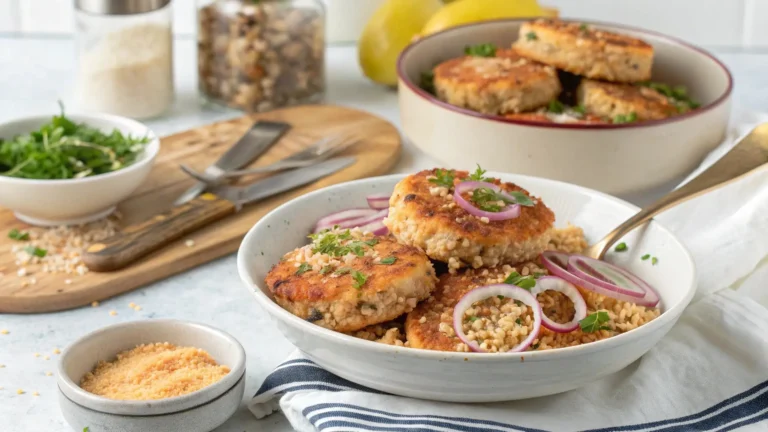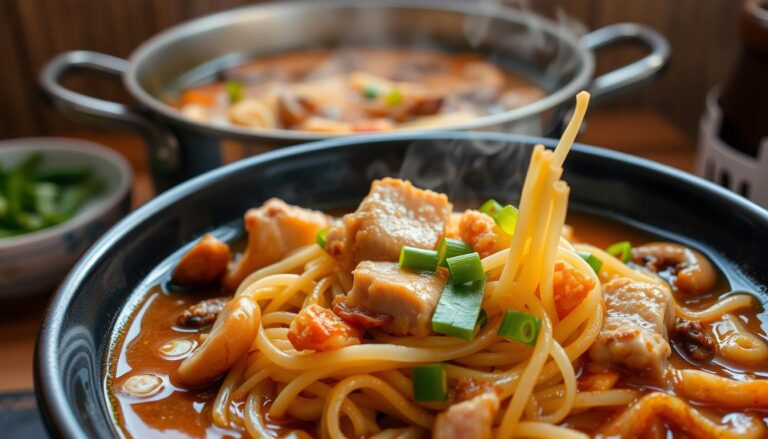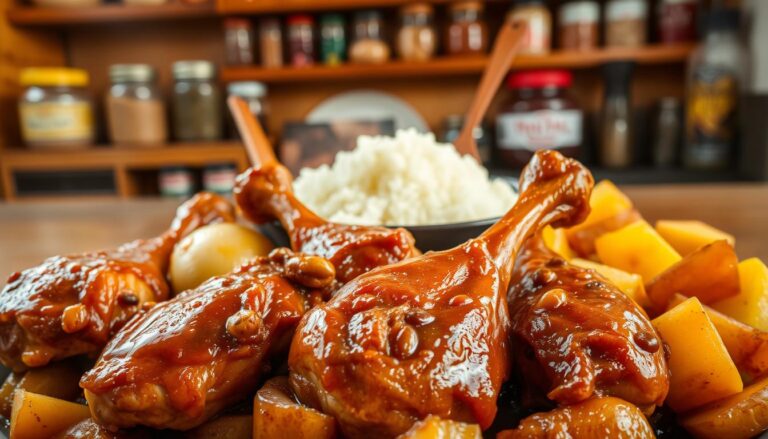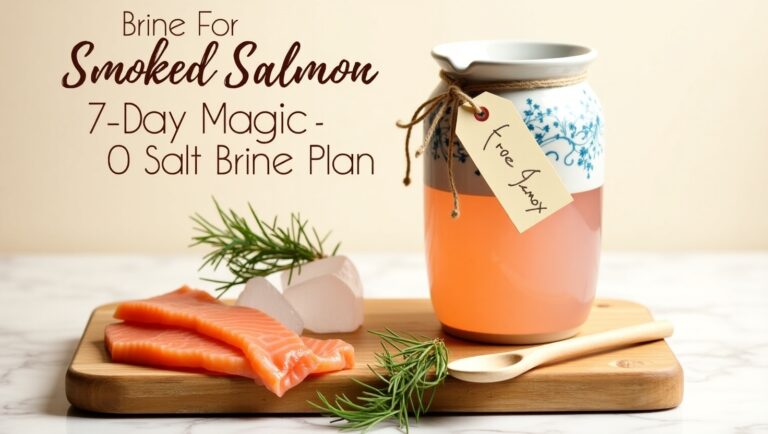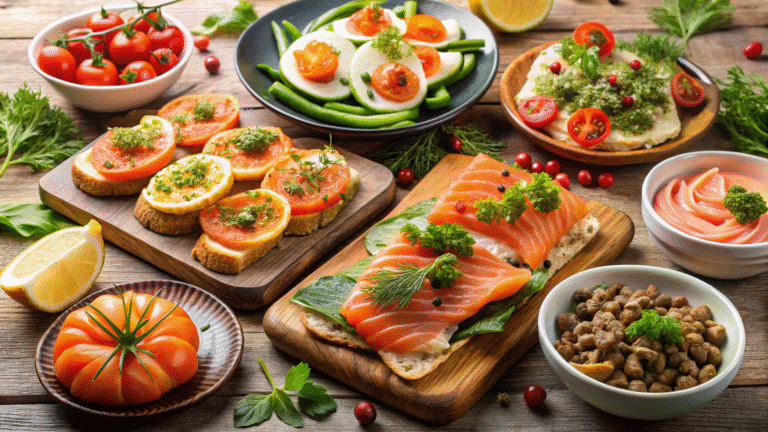Smoked Salmon Internal Temp: How to Check Without Thermomete

Every time I fire up my smoker, I remember the first salmon disaster I created. It was a dry, overcooked mess that broke my culinary heart. Learning the secrets of smoked salmon internal temp changed my cooking forever. Whether you’re a home cook or aspiring chef, mastering salmon cooking temperature is key to mouthwatering, perfectly smoked fish.
Achieving the right smoked salmon internal temp isn’t just about taste. It’s about creating a culinary experience that delights your senses and keeps your guests coming back for more. Understanding the precise temperature control turns an ordinary piece of fish into a gourmet masterpiece.
These four essential tricks will change how you approach smoking salmon. Each bite will be succulent, flavorful, and safely prepared. From professional kitchens to backyard smokers, these techniques will elevate your salmon game from amateur to expert.
Key Takeaways
- Temperature control is critical for perfect smoked salmon
- Different smoking methods require unique temperature approaches
- Internal temperature impacts both safety and flavor
- Proper equipment makes temperature monitoring easier
- Practice and patience lead to smoking success
Understanding the Importance of Smoked Salmon Internal Temp
Mastering the smoked fish internal temperature is key to a tasty and safe dish. When cooking salmon, knowing the right temperatures can make a big difference.
Cooking salmon needs precision. The safe temp for smoked salmon is not just about avoiding illness. It’s also about bringing out amazing flavors and textures.
Why Temperature Matters in Cooking Fish
Temperature is very important in cooking fish. It affects:
- Protein structure
- Moisture retention
- Flavor development
- Texture quality
The Risks of Undercooked Salmon
Raw or undercooked salmon can have harmful bacteria like Listeria and Salmonella. These can lead to serious health issues. So, it’s crucial to control the temperature carefully.
| Salmon Type | Safe Internal Temperature | Potential Risks |
|---|---|---|
| Cold Smoked | 145°F | Bacterial growth |
| Hot Smoked | 145°F | Parasitic infections |
Flavor Enhancement Through Proper Cooking
“Great cooking is about precision and passion” – Chef Marcus Samuelsson
Proper temperature control does more than keep you safe. It also makes your salmon taste better. The right heat breaks down proteins, making the texture great and intensifying the flavors.
Ideal Internal Temperature for Smoked Salmon
Knowing the best temperature for smoked salmon is key to making a tasty and safe dish. The salmon’s doneness temperature affects both taste and safety. It ensures you get the right texture and flavor every time.
When smoking salmon, you’ll use either cold smoking or hot smoking. Each method needs a different temperature to get the best results.
Hot Smoked Salmon Temperature Range
Hot smoked salmon should be cooked to an internal temperature of 145°F to 150°F. This temperature:
- Makes the proteins denature completely
- Kills harmful bacteria
- Gives a rich, flaky texture
- Improves the flavor
Cold Smoked Salmon Considerations
Cold smoking is different. It uses lower temperatures, around 90°F, to keep the salmon’s texture silky and delicate. Professional smokers carefully control these low temperatures to maintain food safety.
Whether you choose hot or cold smoking, always use a meat thermometer. This ensures your smoked salmon is both safe and delicious.
Techniques for Measuring Internal Temp
Learning to check the internal temperature of smoked salmon is key to making it perfect. Knowing the right temperature ensures your fish is both safe and tastes great.
Getting the temperature right is important for safety and flavor. Here are the best ways to check if your salmon is done.
Using a Food Thermometer
A digital food thermometer is the best tool for checking smoked salmon’s internal temperature. Here’s how to use it correctly:
- Choose a thin, sharp-pointed digital thermometer
- Insert the probe into the thickest part of the salmon
- Ensure the tip doesn’t touch bone or skin
- Wait for a stable reading
“The key to perfect smoked salmon is precision, not guesswork.” – Professional Chef
Visual Cues for Doneness
While a thermometer is the most accurate, experienced cooks also look for visual signs:
- Color change: Salmon shifts from translucent to opaque
- Flaky texture when gently pressed
- Protein white droplets appearing on surface
Timing as a Guideline
Cooking time can be a rough guide, but it’s not as reliable as temperature checking. The thickness of the salmon, the smoker’s temperature, and the size of the fillet all affect cooking time.
Pro tip: Always check the internal temperature before relying on cooking time. This ensures your smoked salmon is safe and delicious.
Different Methods of Smoking Salmon
Smoking salmon is an art that requires choosing the right technique. This ensures the perfect flavor and texture. Knowing the different smoking methods helps you master the smoked salmon internal temp. It also makes sure your salmon is safe and delicious.
Cold Smoking vs. Hot Smoking
There are two main methods in salmon smoking: cold smoking and hot smoking. Each method affects the smoked salmon safe temperature and the final product in different ways.
- Cold Smoking: Preserves raw fish at low temperatures between 70-90°F
- Hot Smoking: Cooks salmon while adding smoky flavor at 120-180°F
Equipment for Smoking Salmon
| Smoking Method | Required Equipment | Temperature Range |
|---|---|---|
| Cold Smoking | Smoker with temperature control, wood chips, cooling rack | 70-90°F |
| Hot Smoking | Electric or charcoal smoker, thermometer, wood chips | 120-180°F |
Impact on Flavor and Texture
Your chosen smoking method greatly affects the salmon’s final taste and texture. Hot smoking makes the salmon flaky and fully cooked, with a strong smoky flavor. Cold smoking gives a silky texture and subtle smoke notes.
“The secret to perfect smoked salmon lies in understanding temperature and technique.” – Professional Chef
Choosing the right smoking method depends on your equipment, taste preferences, and comfort with different temperatures. Try different methods to find your favorite way to smoke salmon!
How to Prepare Your Salmon for Smoking
Preparing salmon for smoking is an art. It needs careful selection, preparation, and seasoning. Your success starts long before smoking. Knowing the right techniques makes your salmon truly special.
Selecting the Perfect Salmon Fillet
Choosing the right salmon fillet is key. Look for these qualities:
- Fresh, bright-colored salmon with firm flesh
- Wild-caught salmon for richer flavor
- Thick, even-cut fillets without skin blemishes
- Preferably center-cut pieces for consistent smoking
Brining Techniques for Enhanced Flavor
Brining is a crucial step. It controls the salmon cooking temperature and adds flavor.
| Brine Ingredient | Purpose | Recommended Amount |
|---|---|---|
| Kosher Salt | Moisture retention | 1/4 cup per quart of water |
| Brown Sugar | Balancing saltiness | 2-3 tablespoons |
| Maple Syrup | Subtle sweetness | 2 tablespoons |
Seasoning Tips for Maximum Flavor
After brining, seasoning can transform your salmon. Experiment with dry rubs or herb mixtures that complement the fish’s natural richness. Consider ingredients like:
- Black pepper
- Dill
- Garlic powder
- Smoked paprika
Remember, proper preparation is key. It sets the stage for perfectly smoked salmon with ideal internal temperature and incredible taste.
Safety Tips for Handling Raw Salmon
It’s important to handle raw salmon safely to avoid foodborne illnesses. This keeps your smoked salmon quality high. Safe handling practices protect you and your family from health risks.

Safe Storage Practices
Start by keeping raw salmon at a safe temperature before cooking. Here are key storage tips:
- Keep raw salmon refrigerated at 40°F or below
- Store in the coldest part of your refrigerator
- Use a sealed container or tight plastic wrap
- Consume within 1-2 days of purchase
Cross-Contamination Prevention
Preventing cross-contamination is key when handling raw salmon. This ensures your smoked salmon stays safe:
- Use separate cutting boards for raw fish
- Wash hands thoroughly before and after handling
- Clean all surfaces with hot, soapy water
- Use different utensils for raw and cooked salmon
Understanding Date Labels
It’s important to know the difference between “sell by” and “use by” dates:
| Date Label | Meaning | Recommended Action |
|---|---|---|
| Sell By Date | Store’s inventory guideline | Purchase before this date |
| Use By Date | Last recommended consumption date | Consume or freeze by this date |
Pro tip: When in doubt, always prioritize food safety and discard salmon that appears or smells suspicious.
Common Mistakes to Avoid When Smoking Salmon
Smoking salmon is an art that needs precision and care. Many home cooks make mistakes that can ruin their smoked fish. Knowing these common errors will help you get the best temperature for smoked salmon and ensure it’s cooked right.
The Perils of Improper Smoking Techniques
Smoking salmon isn’t just about putting fish in a smoker. It requires careful attention to several key factors. These can make or break your dish. Here are the most important mistakes to avoid:
- Over-Smoking or Under-Smoking: This can change the texture and flavor of your salmon
- Neglecting internal temperature monitoring
- Skipping the critical resting period after smoking
Monitoring Your Salmon’s Internal Temperature
The salmon doneness temperature is key for flavor and safety. Ignoring it can lead to:
- Dry, tough fish
- Potential foodborne illness
- Uneven cooking
“Precision is the key to perfect smoked salmon” – Professional Chef
The Importance of Resting Your Smoked Salmon
Many home chefs forget to let salmon rest after smoking. This step lets the best temperature for smoked salmon spread evenly. It makes the fish tender and flavorful. Usually, a 5-10 minute rest keeps the fish moist and adds depth to its flavor.
By avoiding these common mistakes, you’ll make your smoked salmon amazing. You’ll impress yourself and your guests with top-notch results.
Serving Suggestions for Smoked Salmon
Getting the internal temperature right is just the start. The way you serve smoked salmon can make it truly special. Learning how to present and pair it will take your meal to the next level.
Ideal Pairings That Complement Flavor
Pairing is key when it comes to smoked salmon. The temperature affects its taste and texture. So, choose the right sides to match.
- Cream cheese and capers
- Crisp white wines
- Lemon wedges
- Dill garnish
Creative Serving Ideas
Make your smoked salmon look as good as it tastes. Choose elegant ways to serve it.
- Appetizer Platter: Arrange thin slices on a wooden board
- Bagel topping with cream cheese
- Salmon tartare
- Rolled pinwheel canapés
Accompaniments That Enhance Flavor
| Accompaniment | Flavor Profile | Recommended Pairing |
|---|---|---|
| Cucumber | Fresh, crisp | Cold-smoked salmon |
| Horseradish | Spicy, sharp | Hot-smoked salmon |
| Pickled onions | Tangy, acidic | Both smoking styles |
The internal temperature of your smoked salmon is key. It affects its texture and taste. By picking the right sides and serving style, you’ll make a meal to remember. It will showcase the salmon’s delicate flavors beautifully.
How to Store Smoked Salmon
Storing smoked salmon right is key to keeping it tasty and safe. Knowing how to refrigerate, freeze, and reheat it is important. This helps keep the flavor good and avoids food sickness.

It’s vital to keep smoked salmon at a safe temperature. This stops bacteria from growing. The internal temperature of the salmon is crucial for both cooking and keeping it fresh.
Refrigeration Guidelines
Here’s how to store smoked salmon in the fridge:
- Keep salmon in an airtight container
- Store at 38-40°F (3-4°C)
- Consume within 3-5 days of opening
- Always check for any signs of spoilage
Freezing Smoked Salmon
Freezing is great for keeping smoked salmon fresh longer. To freeze safely:
- Wrap tightly in plastic wrap or freezer paper
- Place in a freezer-safe bag or container
- Remove as much air as possible
- Freeze at 0°F (-18°C) or lower
- Use within 2-3 months for best quality
Best Practices for Reheating
When reheating smoked salmon, control the temperature well. Gently warm the salmon to prevent drying out or overcooking. Here are some ways to do it:
- Microwave on low power for 30 seconds
- Warm in oven at 275°F for 10-15 minutes
- Use a food thermometer to check internal temperature
Always keep food safety in mind. Check temperatures and store smoked salmon correctly. These tips will ensure you enjoy great-tasting smoked salmon every time.
Health Benefits of Smoked Salmon
Smoked salmon is more than just a tasty treat. It’s a nutritional powerhouse that boosts your health. Knowing the right cooking temperatures helps unlock its full benefits.
Salmon is a health superstar. It’s packed with nutrients that make it a great choice for your meals. Let’s dive into what makes this fish so special.
Nutritional Powerhouse
Smoked salmon is full of good stuff. A single serving gives you:
- High-quality protein
- Essential vitamins and minerals
- Low-calorie protein source
Omega-3 Fatty Acids and Their Benefits
Omega-3 fatty acids are key in smoked salmon. They offer big health perks:
| Omega-3 Benefit | Health Impact |
|---|---|
| Heart Health | Reduces inflammation, supports cardiovascular function |
| Brain Function | Enhances cognitive performance, supports mental clarity |
| Anti-Inflammatory | Helps manage chronic inflammation |
When cooking smoked salmon, keeping the right internal temperature is crucial. Proper cooking techniques protect the delicate omega-3 fatty acids. This way, you get the most health benefits.
Adding smoked salmon to your meals is more than just a tasty choice. It’s a smart move for your health. It’s a nutrient-rich protein that supports your body in many ways.
Recipes Featuring Smoked Salmon
Smoked salmon adds amazing flavor and nutrition to many dishes. It’s great for both cooking experts and beginners. Knowing the best temperature for smoked salmon can make your dishes better. These recipes show how versatile and delicious it is, ensuring it’s cooked just right.
Breakfast Delights
Begin your day with salmon dishes that are full of protein. They highlight the delicate texture and rich flavor of smoked salmon.
- Smoked Salmon Bagel Benedict
- Toasted bagel
- Cream cheese spread
- Sliced smoked salmon
- Poached egg
- Hollandaise sauce
- Salmon Scrambled Eggs
- Fluffy scrambled eggs
- Chopped smoked salmon
- Fresh chives
- Cracked black pepper
Lunch and Dinner Options
Make your main meals exciting with these smoked salmon recipes. They show the perfect serving temperature and flavor.
| Recipe | Key Ingredients | Preparation Time |
|---|---|---|
| Salmon Pasta Salad | Penne, smoked salmon, capers, dill | 20 minutes |
| Salmon Quinoa Bowl | Quinoa, smoked salmon, avocado, cucumber | 25 minutes |
Snacks and Appetizers
Quick bites with smoked salmon are perfect for parties or snacks. Make sure to keep the salmon at the right temperature for the best taste.
- Salmon Cucumber Rounds
- Cream cheese
- Smoked salmon slices
- Fresh dill garnish
- Salmon Pinwheels
- Tortilla wrap
- Herbed cream cheese
- Smoked salmon
Pro tip: Always ensure your smoked salmon is stored and served at the proper temperature to maximize flavor and food safety.
Frequently Asked Questions about Smoked Salmon Temp
Smoked salmon can raise many questions about safety and preparation. Knowing the right temperature is key for both home cooks and food lovers. Let’s look at some common questions to help you enjoy this seafood safely.
Eating undercooked salmon is risky. It can lead to harmful bacteria like listeria and salmonella. Chefs say to cook it to 145°F to avoid foodborne illnesses and make it safe and tasty.
Smoking salmon at home is doable with the right tools and knowledge. You’ll need a smoker, quality salmon, and a food thermometer. Cold smoking needs more care, but hot smoking is easier for beginners. Always keep your salmon at the right temperature for safety.
Smoked salmon lasts 5-7 days in the fridge if stored right. Frozen salmon can last up to three months. Keep it at 40°F or below to keep it fresh and prevent bacteria. Following these tips will help you enjoy your smoked salmon safely and enjoyably.


